Your Guide to the Captain Cook Snorkel Tour
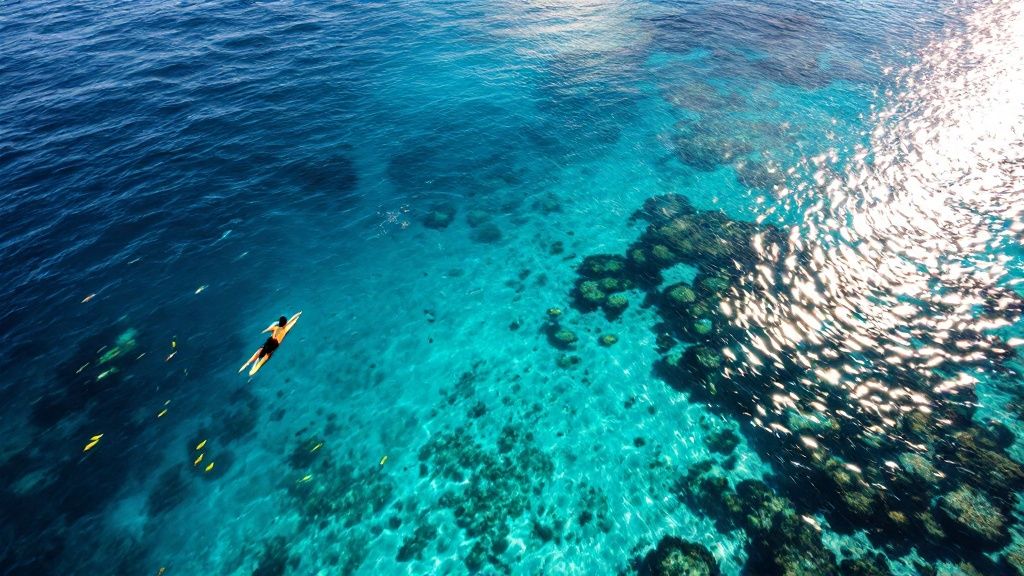
Picture this: you're floating effortlessly in calm, turquoise water, surrounded by brilliant coral reefs and shimmering schools of tropical fish. This is what the Captain Cook snorkel tour is all about. It's one part ocean adventure, one part history lesson, and easily one of Hawaii's most incredible marine experiences.
Your Adventure into Kealakekua Bay
Think of this guide as your insider's map to planning the perfect trip to Kealakekua Bay, which happens to be one of Hawaii's most protected and historically important marine sanctuaries. The trip out to the Captain Cook Monument isn't just a boat ride; it’s your ticket into a thriving underwater world.
The bay's geography is unique, creating a naturally sheltered spot with stunningly clear water—we're talking visibility that often hits 100 feet or more. This makes it an amazing place for snorkelers of all skill levels, whether you're just getting your fins wet for the first time or you're a seasoned pro.
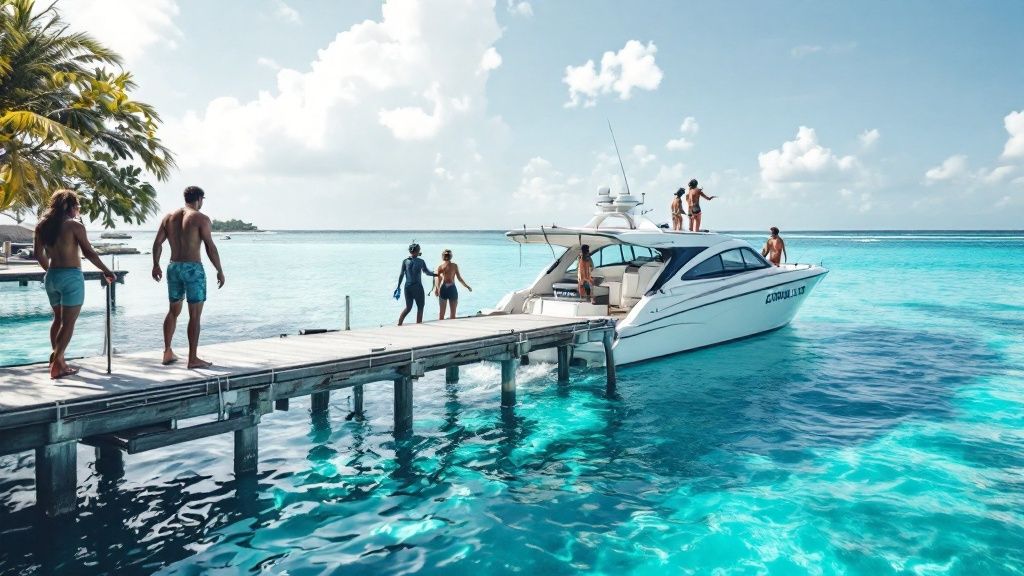
So, What Makes This Tour Stand Out?
Unlike a lot of other snorkeling spots, a trip to Kealakekua Bay isn't just about the fish. You get stunning natural beauty mixed with a heavy dose of Hawaiian history. That striking white obelisk you see on the shoreline is the Captain Cook Monument, marking a major turning point in the islands' past.
This historical backdrop gives the whole experience a different feel, turning a fun day on the water into a real exploration of Hawaii's nature and culture.
Here’s a quick rundown of what we'll cover to get you ready for your trip:
- Picking the Right Tour: We'll look at the different kinds of boats and trips you can book.
- What You'll See: Get ready to meet some incredible marine life, including the beloved honu (Hawaiian green sea turtle).
- Staying Safe & Packing Smart: We'll share some practical tips on what to bring and how to be a respectful visitor in this sacred place.
Our goal is simple: to make sure your journey is just as amazing as the destination itself. For an even deeper dive, check out this full guide to the Captain Cook Snorkel Tour from one of the best local outfits around.
Alright, let's jump in and start planning.
Why Kealakekua Bay Is a Snorkeler's Paradise
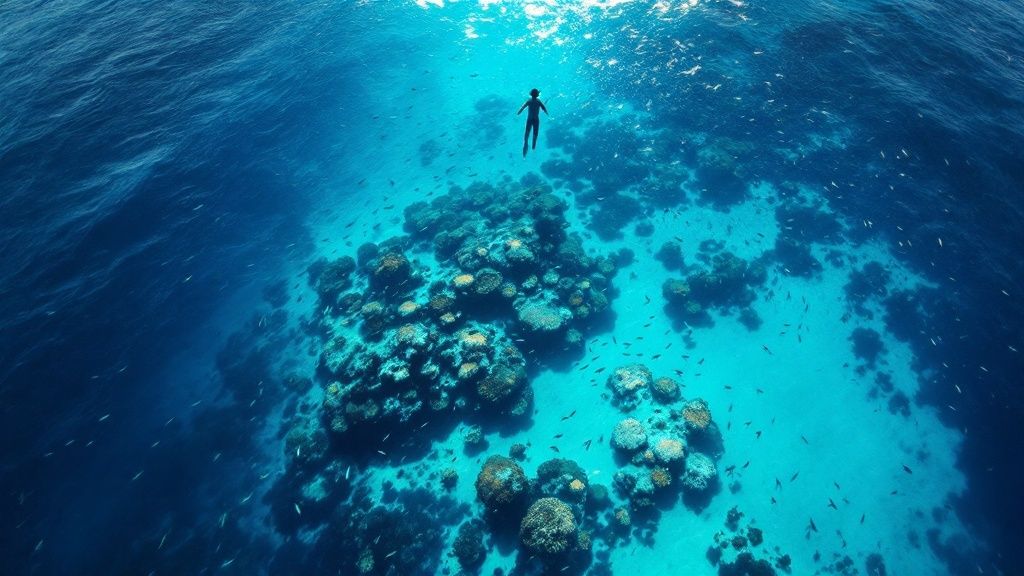
So what's the big deal with a captain cook snorkel tour in Kealakekua Bay? It's more than just the postcard-perfect clear water and the dramatic cliffs hugging the shoreline. This bay is a legally protected Marine Life Conservation District (MLCD), which is basically a national park for everything living underwater.
Because of this special status, the entire ecosystem gets to flourish without the usual pressures from fishing or heavy boat traffic. Picture a pristine, untouched forest, but completely submerged. The payoff for us is an underwater world bursting with a density and variety of sea life you just don't see in many other places.
For snorkelers, this all adds up to a next-level experience. The bay is naturally sheltered by the landscape, creating calm conditions that are perfect for everyone, from first-timers to seasoned pros. On a good day, visibility can hit an incredible 100 feet—it truly feels like you're swimming inside a giant, living aquarium.
A Sanctuary for Abundant Marine Life
That protected status is the direct reason for the sheer number of animals you’ll meet. The bay is a true haven where coral reefs thrive, which in turn provides food and shelter for hundreds of species of tropical fish.
The health of this ecosystem is why you can consistently see such incredible biodiversity. From the vibrant yellow tang to the elusive octopus hiding in plain sight, the bay is a bustling metropolis of marine creatures.
This safe environment also makes it a favorite rest stop for some of Hawaii's most iconic residents. You have a really good chance of spotting:
- Honu (Hawaiian Green Sea Turtles): These gentle giants often cruise gracefully along the reef, totally relaxed in their protected home.
- Nai'a (Spinner Dolphins): Pods of spinner dolphins love to visit the bay to rest and play. It's not uncommon to see them putting on a spectacular acrobatic show.
- Humpback Whales: If you're here in the winter months (December to March), you might just get lucky and see these majestic giants breaching offshore.
A Place of History and Natural Wonder
Kealakekua Bay's reputation is well-earned. Famous for being the spot where Captain James Cook arrived in 1779, the area draws around 190,000 visitors every year who come for its unique mix of history and nature.
Its federally protected status makes sure that the vibrant corals and diverse marine life are preserved for all of us to enjoy. This blend of amazing clarity, calm water, and a thriving ecosystem is what makes Kealakekua Bay an absolute paradise. To see more of what makes this place so special, check out our in-depth Kealakekua Bay snorkeling tour guide. It’s the perfect setting for an adventure you won't forget.
How to Choose Your Perfect Snorkel Tour
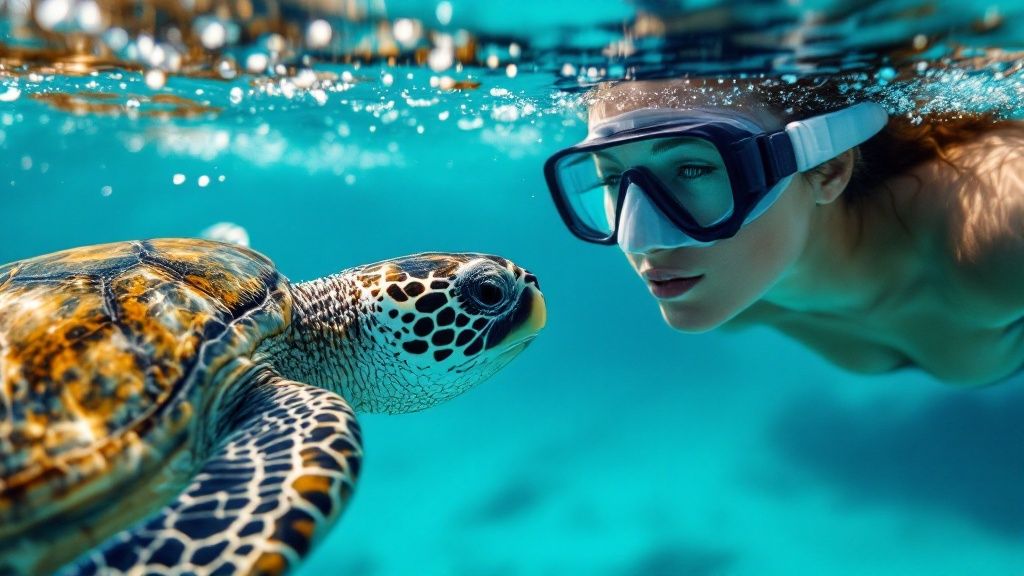
Picking the right captain cook snorkel tour isn't a one-size-fits-all deal. Your entire experience out on Kealakekua Bay really hinges on the kind of boat, the number of people, and the general vibe you choose. Think of it like picking a car for a road trip: a zippy sports car is awesome for a solo cruise down a winding coastal highway, but you'll want an RV for a big family adventure.
Your first big decision is the boat itself. Do you picture yourself on a massive, stable catamaran with tons of space to stretch out, complete with perks like a real bathroom and a buffet lunch? Or is a smaller, zippier Zodiac-style raft—the kind that offers a more personal, up-close adventure—more your speed?
Each one offers a completely different way to see the bay. The best choice comes down to your personal style, your budget, and who you’re traveling with.
Matching Your Travel Style to the Tour
To find that perfect fit, take a second to think about what kind of traveler you are. Are you after a quiet, immersive day with nature, or are you looking for a fun social outing with all the bells and whistles?
-
For Families and Comfort-Seekers: Big catamarans are almost always the way to go. They're super stable (a huge plus for anyone prone to seasickness), have plenty of shade, and offer amenities like slides and easy-to-use swim steps that make the day a breeze, especially with kids in tow.
-
For Adventurous Couples or Solo Travelers: A smaller raft or Zodiac boat delivers a more thrilling ride. These tours tend to feel more intimate, and with fewer people, you get more one-on-one time with your guide.
-
For Those Seeking Ultimate Flexibility: If you're rolling with a larger group or have a very specific day in mind, a private charter is your best bet. You get to call all the shots—timing, how long you stay, and even what's on the menu.
The key is to line up the tour's features with what you actually want out of the day. Don't book a high-speed adventure raft if all you really want to do is lounge in the sun with a drink in your hand.
Comparing Key Tour Features
Not all Captain Cook snorkel tours are created equal. To help you sort through the options, it helps to see how the main tour types stack up against each other. From intimate rafts to large party boats, there's something for every budget and preference.
This table breaks down what you can generally expect from each style of tour.
Captain Cook Snorkel Tour Comparison
| Tour Type | Best For | Typical Duration | Group Size | Average Price Range |
|---|---|---|---|---|
| Small Boat / Raft | Adventure-seekers, couples, small groups | 3-4 hours | 6-12 guests | $80 – $120 |
| Large Catamaran | Families, comfort-seekers, large groups | 4-5 hours | 20-40+ guests | $100 – $150 |
| Private Charter | Ultimate flexibility, special occasions | Customizable | Your group only | $500+ |
Understanding these differences is the secret to picking a tour you'll love. It’s not just about the price tag; it’s about the kind of experience you're paying for. A shorter, no-frills tour might be perfect if you just want a quick dip in the water. But if you're looking for a full day's activity, a longer tour that includes lunch and multiple snorkel spots often provides much better value.
By weighing factors like duration, amenities, and group size, you can confidently book the perfect captain cook snorkel tour for a truly unforgettable adventure. You can explore more details about these tour options to see how they compare.
The Story Behind the Captain Cook Monument
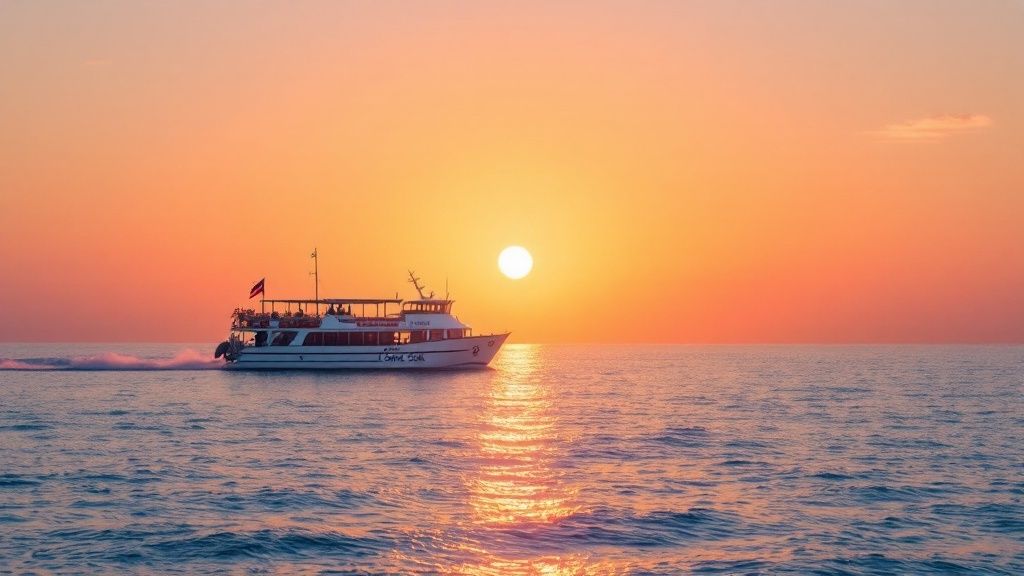
As your boat pulls into the calm, protected waters of Kealakekua Bay, you can't miss it: a stark white obelisk standing tall against the lush, green cliffs. This is the Captain Cook Monument, and it marks a spot that’s absolutely pivotal in Hawaiian history. Knowing its story will completely change your snorkel trip, turning a fun day on the water into a much richer, more meaningful experience.
The monument commemorates Captain James Cook, the legendary British explorer who was the first Westerner to make recorded contact with the Hawaiian Islands back in 1778. His arrival kicked off a new era, but his final stop in Kealakekua Bay in 1779 ended in disaster.
At first, Cook and his crew were welcomed—some historians believe they were even seen as manifestations of the Hawaiian god Lono. But as time went on, cultural misunderstandings and conflicts over resources began to fray relations. Things hit a boiling point when Cook tried to kidnap a high-ranking Hawaiian chief, Kalaniʻōpuʻu, in an attempt to get a stolen cutter boat back. This move sparked a violent clash right on the shoreline, leading to Cook's death on February 14, 1779.
A Symbol of Complex History
The 25-foot monument you see today wasn't actually built until nearly a hundred years after the incident. It was funded and constructed by the British to memorialize their fallen explorer. Fun fact: it sits on a tiny piece of land that is technically deeded to the United Kingdom, a strange little holdover from colonial times right here on Hawaiian soil.
For many, this monument is more than just a stone pillar. It represents a complicated, and often painful, collision of cultures. While it honors a world-renowned explorer, it also marks the site of a deadly conflict and the start of a period that forever changed the Hawaiian way of life.
The historical storytelling is a huge part of what makes a captain cook snorkel tour so special. The best guides don't just point out fish; they share detailed stories about Cook's voyages and the deep significance of Kealakekua Bay, turning a regular snorkel trip into a powerful journey through time.
This historical backdrop adds so much depth to your visit. As you float in the clear, calm water, you're not just in a beautiful bay—you're swimming through a living museum. To dive even deeper, check out our dedicated guide on everything you need to know about snorkeling Captain Cook Monument in Hawaii.
The Monument's Role Today
Today, that history is front and center on the tour. The guides on your boat are usually fantastic storytellers who bring this complex past to life, often sharing perspectives from both Hawaiian and Western viewpoints. Hearing the story while you're physically at the site where it all happened is a powerful experience.
It gives you a much richer appreciation for Kealakekua Bay—it's not just a snorkeler's paradise, but a place of immense cultural and historical weight.
What to Pack for Your Snorkeling Adventure
A little bit of prep work can make the difference between a good day on the water and a truly epic one. While your Captain Cook snorkel tour operator handles the big stuff—like the boat and snorkel gear—a few personal items will make your trip that much more comfortable and safe.
First, let's talk about what you can leave at home. Pretty much every tour company will provide the essential snorkeling equipment. That means a properly fitted mask, snorkel, and fins. They'll also have mandatory safety gear like life vests or other flotation devices to make sure everyone feels secure out in the bay.
Your Go-To Checklist for a Perfect Day
With the basics taken care of, you can focus on packing for comfort, sun protection, and being a good steward of the reef. Here's a quick rundown of what you should definitely toss in your bag:
- Reef-Safe Sunscreen: This is a big one. Regular sunscreens have chemicals like oxybenzone that are seriously damaging to our fragile coral reefs. Hawaii has even banned their sale. Grab a mineral-based, reef-safe option—it’s a simple choice that helps protect Kealakekua Bay for years to come.
- Swimsuit & Towel: Seems obvious, right? But you'd be surprised. Pro-tip: wear your swimsuit under your clothes to the boat. It just makes things easier.
- Sun Protection Gear: The Hawaiian sun is no joke, especially when it’s bouncing off the water. A wide-brimmed hat, polarized sunglasses, and a long-sleeve rash guard or cover-up are your best friends out there.
- Reusable Water Bottle: Staying hydrated is key. Most tours offer water, but bringing your own reusable bottle is a great way to cut down on plastic waste and make sure you always have water on hand.
The one thing people always forget? A dry bag. Seriously, this little waterproof sack is a game-changer. It’ll keep your phone, wallet, and car keys bone dry while you’re off exploring the reef, so you can snorkel without a single worry.
Thinking about photos? You'll absolutely want to capture the incredible underwater world at the Captain Cook monument. An underwater camera or even just a solid waterproof phone case will let you bring home memories of those vibrant schools of fish and ancient coral gardens.
Essential Packing Checklist
To make it even simpler, here’s a quick-glance table. It breaks down what you’ll need to pack versus what your tour guide will likely have waiting for you on the boat.
| What to Bring Yourself | What Tour Operators Typically Provide |
|---|---|
| Reef-Safe Sunscreen | Professionally Fitted Mask |
| Swimsuit (wear it!) | Snorkel |
| Towel | Fins (flippers) |
| Hat & Sunglasses | Life Vests/Flotation Devices |
| Rash Guard or Cover-Up | Water & Light Snacks |
| Reusable Water Bottle | Professional Guides & Safety Briefing |
| Dry Bag for Valuables | First-Aid Kit |
| Underwater Camera/Phone Case |
Packing smart means you can relax and focus on what you came for: an unforgettable day snorkeling in one of Hawaii's most historic and beautiful bays.
Snorkeling Safely and Respectfully in a Sacred Place
Kealakekua Bay isn't just a pretty snorkel spot; it's a living, breathing treasure. Hopping on a captain cook snorkel tour is an incredible experience, and it comes with a shared kuleana (responsibility) to keep this place special. Your guides are absolute pros when it comes to safety, but being mindful yourself is what really makes for a safe and amazing day in the water.
It’s the simple things that count. Always give your full attention to the crew’s safety briefing before you even think about getting in. They know the day's specific currents and conditions better than anyone. It’s also super important to be honest with yourself about your swimming skills and never stray too far from the boat. And that Hawaiian sun is no joke—staying hydrated is key, so keep sipping water all day long.
Practicing Malama Aina (Caring for the Land)
Beyond just looking out for yourself, snorkeling here is about protecting a fragile underwater world. The golden rule is simple: look, but don't touch. That coral might look like a cool rock, but it's actually a massive colony of tiny, living animals. A single touch can injure or even kill it.
The same hands-off approach goes for all the marine life you'll meet, especially the beloved honu (Hawaiian green sea turtles). They're protected by law for a reason. Just give them plenty of space, and you'll get to see them acting naturally in their own home.
Think of it as leaving no trace. Everything you bring with you needs to leave with you. This simple act helps keep the bay pristine for all the wildlife and future visitors who get to experience its magic.
Protecting this sacred place actually starts before you even step on the boat. One of the biggest things you can do is choosing the right sunscreen. Taking a moment for understanding what reef-safe sunscreen is and picking a mineral-based one makes a massive difference. The chemicals in most sunscreens are incredibly toxic to coral reefs.
When you put these simple safety and respect practices together, you become part of the solution, helping to protect this incredible ecosystem. For a deeper dive into staying safe out there, check out our guide on essential snorkeling safety tips.
Got Questions About the Tour? We've Got Answers.
Even after reading all the details, you probably still have a few things you're wondering about before you book your Captain Cook snorkel tour. It's totally normal. This is where we'll tackle the most common questions head-on, so you can feel 100% confident you're making the right choice for an amazing day on the water.
Let's get everything cleared up.
Is This Tour Good for Beginners or Non-Swimmers?
Absolutely. Don't let a lack of experience hold you back. The tour operators here are pros at making first-time snorkelers feel right at home. The waters of Kealakekua Bay are famously calm and sheltered, which makes it just about the perfect place to learn.
The crew will hook you up with all the gear you need, including life vests and flotation noodles, so everyone feels secure in the water. They give a solid rundown of what to do before you even dip a toe in, meaning even if you're not a strong swimmer, you can just float peacefully and soak in the incredible underwater scenery without a worry in the world.
What's the Best Time of Year to Go?
Honestly, there's no bad time for snorkeling on the Big Island, but different seasons do have their perks. The summer months, from about April through October, usually bring the flattest, calmest ocean conditions and consistently sunny skies. It’s ideal for a super relaxing day out there.
But then there's winter. The months from December through March are the heart of whale-watching season. It's a truly incredible experience—while you're snorkeling, you might actually hear the haunting songs of humpback whales echoing underwater. Or, on your boat ride to the bay, you could see one breach clear out of the water.
The bottom line is, the fish and coral in the bay are fantastic no matter when you visit. The real question is whether you want the calmest water possible or the chance to witness the awesome power of humpback whales.
How Likely Am I to See Dolphins or Whales?
Your chances of spotting Hawaiian spinner dolphins (nai'a) are extremely good. These guys are year-round residents and Kealakekua Bay is one of their favorite spots to rest and play. Seeing a pod of them is a common—and always thrilling—part of the tour.
Seeing humpback whales, on the other hand, is a seasonal treat. If you book your tour between December and March, your odds are fantastic. Thousands of humpbacks migrate to Hawaiian waters during these months to breed and have their calves, making for some truly jaw-dropping moments.
Are There Age Restrictions for Children?
This really depends on the specific tour company, so you should always double-check when you book. For the most part, the larger catamaran tours are super family-friendly and welcome kids of all ages, often having smaller-sized gear ready for them.
Some of the smaller, zippier raft-style boats might have a minimum age, often around 4 or 5 years old, just because the ride can be faster and a bit bumpier. Just give your chosen company a quick call to confirm the trip is a good fit for your little ones.
Ready to see the magic of Kealakekua Bay for yourself? Kona Snorkel Trips runs expertly guided tours that are safe, a ton of fun, and perfect for every skill level. Book your unforgettable Captain Cook adventure today!
